Nikon Flash Comparison
Technically, the article is supposed to be called “Nikon Speedlight Comparison”, because Nikon calls their flash units “Speedlights”. This article is written as an introduction to the current and older line of Nikon Speedlights, specifically the Nikon SB-300, SB-400, SB-500, SB-600, SB-700, SB-800 (discontinued), SB-900 (discontinued) and SB-910. In addition to some basic information on each Speedlight, I will provide a comparison chart on the bottom of this article as well, to make it simpler for our readers to understand the differences.
1) Nikon SB-300
 The most basic of all Nikon Speedlights, the Nikon SB-300 is also the lightest and the most compact one. It is designed to be used only on top of the camera and cannot work in master/commander or slave/remote modes. Certainly more powerful than the on-camera pop-up flash, the SB-300 flash head can only be tilted upwards up to 120 degrees for bouncing light. Unlike all other Nikon speedlights, the SB-300 cannot rotate from left to right and vice versa, limiting options for bouncing light off various lighting accessories. While it fully supports Nikon’s i-TTL and various sync modes, it does not support some of the Nikon CLS (Creative Lighting System) features such as High Speed Sync and Autofocus Assist. The SB-300 is a very lightweight flash that takes only two AAA Alkaline or Ni-MH batteries. T
The most basic of all Nikon Speedlights, the Nikon SB-300 is also the lightest and the most compact one. It is designed to be used only on top of the camera and cannot work in master/commander or slave/remote modes. Certainly more powerful than the on-camera pop-up flash, the SB-300 flash head can only be tilted upwards up to 120 degrees for bouncing light. Unlike all other Nikon speedlights, the SB-300 cannot rotate from left to right and vice versa, limiting options for bouncing light off various lighting accessories. While it fully supports Nikon’s i-TTL and various sync modes, it does not support some of the Nikon CLS (Creative Lighting System) features such as High Speed Sync and Autofocus Assist. The SB-300 is a very lightweight flash that takes only two AAA Alkaline or Ni-MH batteries. T2) Nikon SB-400
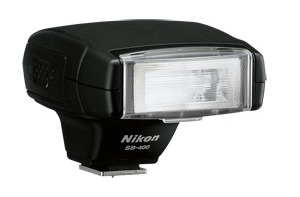 The Nikon SB-400 is another very basic flash unit. It is very similar to the SB-300, except it only allows the head to be tilted 90 degrees upwards (which is pretty limiting). It also won’t work in master/commander or slave/remote modes. Just like the SB-300, it cannot rotate side to side either, making it impossible to bounce the light off walls and other vertical surfaces, unless the camera is positioned in a vertical orientation. The SB-400 has a faster recycle time than the SB-300, lasts longer and is slightly larger in size. Nikon’s i-TTL is also fully supported, except for High Speed Sync and AF Assist.
The Nikon SB-400 is another very basic flash unit. It is very similar to the SB-300, except it only allows the head to be tilted 90 degrees upwards (which is pretty limiting). It also won’t work in master/commander or slave/remote modes. Just like the SB-300, it cannot rotate side to side either, making it impossible to bounce the light off walls and other vertical surfaces, unless the camera is positioned in a vertical orientation. The SB-400 has a faster recycle time than the SB-300, lasts longer and is slightly larger in size. Nikon’s i-TTL is also fully supported, except for High Speed Sync and AF Assist.3) Nikon SB-500
 The newly announced SB-500 is the first Nikon speedlight to come with built-in LED lights for use as continuous / video light (the LED light can function independently from the main flash). With a guide number of 24m, it might not be as powerful as the higher-end speedlights, but it is still a pretty capable flash that can be used as a commander to trigger other flashes, or as a slave. Its head is quite flexible and can be either tilted up to 90° or rotated from 0° to 180°, just like the higher-end models. Due to its limited power comprising of 2 AA size batteries, the recycling time is quite poor at 3.5 seconds. Not a bad flash to get into flash photography with and could be fairly useful as a slave in combination with the camera pop-up flash operating as a master. Fully compatible with the Nikon CLS system.
The newly announced SB-500 is the first Nikon speedlight to come with built-in LED lights for use as continuous / video light (the LED light can function independently from the main flash). With a guide number of 24m, it might not be as powerful as the higher-end speedlights, but it is still a pretty capable flash that can be used as a commander to trigger other flashes, or as a slave. Its head is quite flexible and can be either tilted up to 90° or rotated from 0° to 180°, just like the higher-end models. Due to its limited power comprising of 2 AA size batteries, the recycling time is quite poor at 3.5 seconds. Not a bad flash to get into flash photography with and could be fairly useful as a slave in combination with the camera pop-up flash operating as a master. Fully compatible with the Nikon CLS system. 4) Nikon SB-600
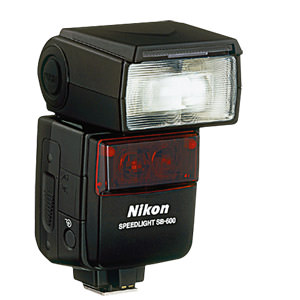 Discontinued a couple of years ago, the Nikon SB-600 is a very capable flash that has a flexible head for both tilting (up and down) and rotating (left and right). It can only be used either on-camera or off-camera as a slave (no master / commander mode). The Nikon SB-600 supports most Nikon CLS features and uses four AA batteries with a good recycle time. Unlike the Nikon SB-300, SB-400 and SB-500, it has an LCD screen on the back of the flash for flash setup options. When compared to the higher-end SB-700, the SB-600 does not come with a diffusion dome (useful for indoors shots) and color gels. It does come with a stand though, which can be put on a flat surface or mounted on a tripod when used as a slave unit (off-camera flash). The Nikon SB-600 will automatically zoom in/out for focal lengths between 24-85mm. It has no sync port, which means that you cannot use it with triggers like PocketWizard Plus II / III (a separate adapter for the sync cord would have to be purchased). New PocketWizard MiniTT1 and FlexTT5 units can be used with this flash.
Discontinued a couple of years ago, the Nikon SB-600 is a very capable flash that has a flexible head for both tilting (up and down) and rotating (left and right). It can only be used either on-camera or off-camera as a slave (no master / commander mode). The Nikon SB-600 supports most Nikon CLS features and uses four AA batteries with a good recycle time. Unlike the Nikon SB-300, SB-400 and SB-500, it has an LCD screen on the back of the flash for flash setup options. When compared to the higher-end SB-700, the SB-600 does not come with a diffusion dome (useful for indoors shots) and color gels. It does come with a stand though, which can be put on a flat surface or mounted on a tripod when used as a slave unit (off-camera flash). The Nikon SB-600 will automatically zoom in/out for focal lengths between 24-85mm. It has no sync port, which means that you cannot use it with triggers like PocketWizard Plus II / III (a separate adapter for the sync cord would have to be purchased). New PocketWizard MiniTT1 and FlexTT5 units can be used with this flash. 5) Nikon SB-700
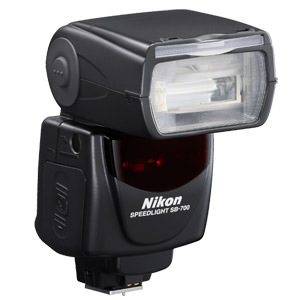 The new Nikon SB-700 is a major step-up from the Nikon SB-600 with a completely redesigned user interface, which is much more intuitive and easier to use than the one on the Nikon SB-600. It fully supports all Nikon CLS features and in addition, can be used as a master/commander to trigger other slave flashes. Compared to the Nikon SB-800/SB-900, the commander mode is somewhat limited, with support of only up to two groups of flashes (Group A and Group B). Its recycle time is fast and the flash can automatically zoom in and out for focal lengths of 24-120mm. It comes with a bunch of accessories such as diffusion dome, colors gels and flash stand. Similar to the Nikon SB-600, the SB-700 also does not come with a sync port, so only the newer PocketWizard triggers like MiniTT1 and FlexTT5 can be used with it without any additional adapters.
The new Nikon SB-700 is a major step-up from the Nikon SB-600 with a completely redesigned user interface, which is much more intuitive and easier to use than the one on the Nikon SB-600. It fully supports all Nikon CLS features and in addition, can be used as a master/commander to trigger other slave flashes. Compared to the Nikon SB-800/SB-900, the commander mode is somewhat limited, with support of only up to two groups of flashes (Group A and Group B). Its recycle time is fast and the flash can automatically zoom in and out for focal lengths of 24-120mm. It comes with a bunch of accessories such as diffusion dome, colors gels and flash stand. Similar to the Nikon SB-600, the SB-700 also does not come with a sync port, so only the newer PocketWizard triggers like MiniTT1 and FlexTT5 can be used with it without any additional adapters. 6) Nikon SB-800
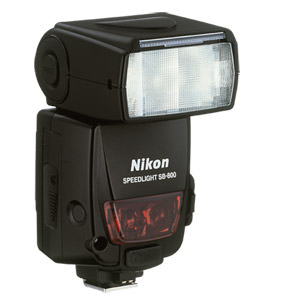 The Nikon SB-800 was discontinued in 2008 after Nikon SB-900 was introduced to the market. It is a great flash that also fully supports all Nikon CLS features such as i-TTL, High Speed Sync and much more. A heavy duty flash that was designed to be used for demanding professionals. The head is very flexible and can be tilted and rotated for bouncing the light off ceilings, walls and other surfaces. It is a fully-featured master/commander and a slave that supports up to three wireless groups (Group A, Group B and Group C). Thanks to the sync port, the Nikon SB-800 can be used with all radio triggers/transmitters, including the traditional PocketWizard models. The nice thing about the SB-800, is that it comes with an extra battery compartment for the fifth battery, which significantly helps in reducing the recycle time and it can take external battery packs for continuous flash shooting. The SB-800 also comes with plenty of accessories such as the diffuser dome, color gels and a stand for off-camera use.
The Nikon SB-800 was discontinued in 2008 after Nikon SB-900 was introduced to the market. It is a great flash that also fully supports all Nikon CLS features such as i-TTL, High Speed Sync and much more. A heavy duty flash that was designed to be used for demanding professionals. The head is very flexible and can be tilted and rotated for bouncing the light off ceilings, walls and other surfaces. It is a fully-featured master/commander and a slave that supports up to three wireless groups (Group A, Group B and Group C). Thanks to the sync port, the Nikon SB-800 can be used with all radio triggers/transmitters, including the traditional PocketWizard models. The nice thing about the SB-800, is that it comes with an extra battery compartment for the fifth battery, which significantly helps in reducing the recycle time and it can take external battery packs for continuous flash shooting. The SB-800 also comes with plenty of accessories such as the diffuser dome, color gels and a stand for off-camera use. 7) Nikon SB-900
 Before the updated SB-910, the best and the most expensive Nikon speedlight was the Nikon SB-900 – a high-end flash unit that replaced the SB-800. The Nikon SB-900 is a very flexible device that can be used both as a master and a slave and fully supports all current Nikon CLS features. The SB-900 has a similar intuitive user interface as the SB-700 and also comes with all accessories for on-camera and off-camera shooting. The flash zoom feature covers 17-200mm, which means that you can cover a very wide area or zoom in and cover a much smaller area for a more defined flash look, similar to a mini-snoot. The PC/sync port is included and just like the SB-800, the SB-900 can also work with external battery packs like SD-9. In terms of recycle time, although the SB-900 can only take 4 batteries maximum, it outperforms the Nikon SB-800 with the extra battery option.
Before the updated SB-910, the best and the most expensive Nikon speedlight was the Nikon SB-900 – a high-end flash unit that replaced the SB-800. The Nikon SB-900 is a very flexible device that can be used both as a master and a slave and fully supports all current Nikon CLS features. The SB-900 has a similar intuitive user interface as the SB-700 and also comes with all accessories for on-camera and off-camera shooting. The flash zoom feature covers 17-200mm, which means that you can cover a very wide area or zoom in and cover a much smaller area for a more defined flash look, similar to a mini-snoot. The PC/sync port is included and just like the SB-800, the SB-900 can also work with external battery packs like SD-9. In terms of recycle time, although the SB-900 can only take 4 batteries maximum, it outperforms the Nikon SB-800 with the extra battery option.8) Nikon SB-910
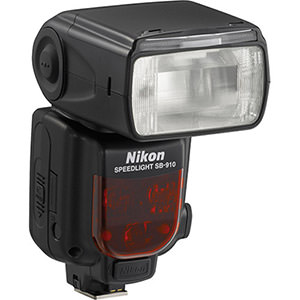 When the Nikon SB-900 came out, it had an issue where it would shut down and refuse to work when it overheated. While this was not an issue for me, since I never abuse my flashes and try to keep them cool by firing at lower power (prefer to stay at 1/2-1/4 max), many photographers started to complain about it. There was no way to fix the overheating issue with a firmware update, so Nikon updated the model with the newer SB-910. In addition to this hardware modification, Nikon made a few other changes to the SB-910. It made slight modifications to the body and control layout, brightened up the LCD, replaced the soft plastic gels with hard plastic ones and made some tweaks to the speedlight menu.
When the Nikon SB-900 came out, it had an issue where it would shut down and refuse to work when it overheated. While this was not an issue for me, since I never abuse my flashes and try to keep them cool by firing at lower power (prefer to stay at 1/2-1/4 max), many photographers started to complain about it. There was no way to fix the overheating issue with a firmware update, so Nikon updated the model with the newer SB-910. In addition to this hardware modification, Nikon made a few other changes to the SB-910. It made slight modifications to the body and control layout, brightened up the LCD, replaced the soft plastic gels with hard plastic ones and made some tweaks to the speedlight menu. Nikon Speedlight Comparison Chart
| Speedlight Feature | SB-300 | SB-400* | SB-500 | SB-600* | SB-700 | SB-800* | SB-900* | SB-910 |
|---|---|---|---|---|---|---|---|---|
| * Nikon SB-400 was discontinued in 2013 * Nikon SB-600 was discontinued in 2012 * Nikon SB-800 was discontinued in 2008 * Nikon SB-900 was discontinued in 2011 | ||||||||
| Guide Number (ISO 100) | 18m | 21m | 24m | 30m | 28m | 38m | 34m | 34m |
| Bounce Head Tilt | Yes | Yes | Yes | Yes | Yes | Yes | Yes | Yes |
| Bounce Head Rotate | No | No | Yes | Yes | Yes | Yes | Yes | Yes |
| Master/Commander Mode | No | No | Yes | No | Yes | Yes | Yes | Yes |
| Slave/Remote Mode | No | No | Yes | Yes | Yes | Yes | Yes | Yes |
| Total Wireless Channels | N/A | N/A | 4 | 4 | 4 | 4 | 4 | 4 |
| Total Wireless Groups | N/A | N/A | 2 (A/B) | N/A | 2 (A/B) | 3 (A/B/C) | 3 (A/B/C) | 3 (A/B/C) |
| Easy Master/Remote Switch | N/A | N/A | Yes | No | Yes | No | Yes | Yes |
| i-TTL | Yes | Yes | Yes | Yes | Yes | Yes | Yes | Yes |
| Monitor Pre-Flashes | Yes | No | Yes | Yes | Yes | Yes | Yes | Yes |
| Modeling Illuminator | No | No | No | No | Yes | Yes | Yes | Yes |
| Repeating Flash | No | No | No | No | No | Yes | Yes | Yes |
| LED Lights | No | No | Yes | No | No | No | No | No |
| Manual Mode | No | No | Yes, via DSLR | Yes | Yes | Yes | Yes | Yes |
| Autofocus Assist | No | No | No | Yes | Yes | Yes | Yes | Yes |
| PC/Sync Socket | No | No | No | No | No | Yes | Yes | Yes |
| Power Source | 2 AAA | 2 AA | 2 AA | 4 AA | 4 AA | 4/5 AA | 4 AA | 4 AA |
| Recycle Time (Ni-MH) | 3.5 Sec | 2.5 Sec | 3.5 Sec | 2.5 Sec | 2.5 Sec | 2.7 Sec | 2.3 Sec | 2.3 Sec |
| Recycle Time (Alcaline) | 4.0 Sec | 3.9 Sec | 4.0 Sec | 3.5 Sec | 2.5 Sec | 6.0/4.0 Sec | 4.0 Sec | 4.0 Sec |
| Flash Duration (Full Power) | 1/1650 Sec | 1/1300 Sec | 1/1100 Sec | 1/900 Sec | 1/1042 Sec | 1/1050 Sec | 1/880 Sec | 1/880 Sec |
| Flash Duration (Half Power) | N/A | N/A | N/A | 1/1600 Sec | 1/1136 Sec | 1/1100 Sec | 1/1100 Sec | 1/1100 Sec |
| Minimum Number of Flashes (Alkaline) | 70 | 140 | 100 | 200 | 160 | 130 | 110 | 110 |
| Minimum Number of Flashes (Ni-MH) | 110 | 210 | 140 | 220 | 230 | 150 | 165 | 165 |
| High Speed Sync | No | No | Yes | Yes | Yes | Yes | Yes | Yes |
| Rear-Curtain Sync | Yes | Yes | Yes | Yes | Yes | Yes | Yes | Yes |
| Slow Sync | Yes | Yes | Yes | Yes | Yes | Yes | Yes | Yes |
| LCD Screen | No | No | No | Yes | Yes | Yes | Yes | Yes |
| Lens Coverage/Zoom | 18/27-200mm | 27mm | 24mm | 24-85mm | 24-120mm | 24-105mm | 17-200mm | 17-200mm |
| FV (Flash Value) Lock | Yes | Yes | Yes | Yes | Yes | Yes | Yes | Yes |
| Flash Compensation | N/A | N/A | Camera Only | -3.0 to +3.0 | -3.0 to +3.0 | -3.0 to +3.0 | -3.0 to +3.0 | -3.0 to +3.0 |
| Flash Color Communication | Yes | Yes | Yes | Yes | Yes | Yes | Yes | Yes |
| Firmware Update | Yes | No | Yes | No | Yes | No | Yes | Yes |
| Diffusion Dome Included | No | No | No | No | Yes | Yes | Yes | Yes |
| Color Gels Included | No | No | No | No | Yes | Yes | Yes | Yes |
| Color Gel Type | N/A | N/A | N/A | N/A | Hard Plastic | Soft Plastic | Soft Plastic | Hard Plastic |
| Flash Stand Included | No | No | Yes | Yes | Yes | Yes | Yes | Yes |
| Can use External Battery Packs | No | No | No | No | No | Yes | Yes | Yes |
| Weight | 97g | 128g | 226g | 300g | 360g | 350g | 415g | 420g |
| Dimensions | 57.4 x 65.4 x 62.3mm | 66 x 56.5 x 80mm | 67 x 114.5 x 70.8mm | 68 x 123.5 x 90mm | 71 x 126 x 104.5mm | 70.6 x 127.4 x 91.7mm | 78 x 146 x 118.5mm | 78.5 x 145 x 113mm |

0 comments: